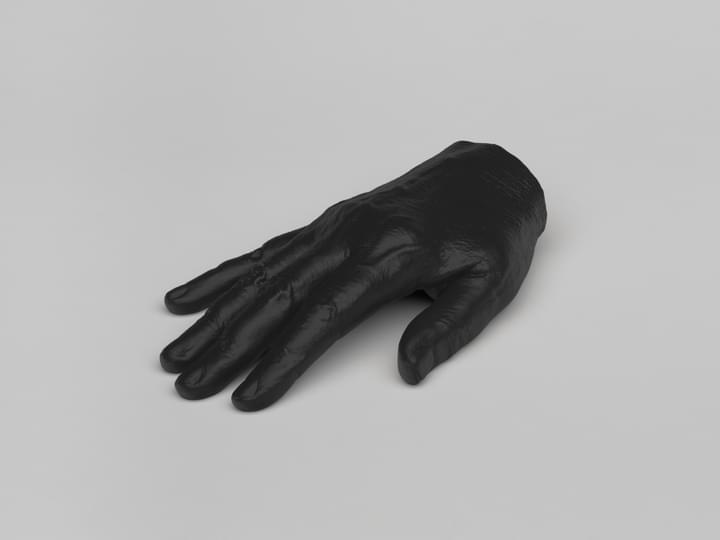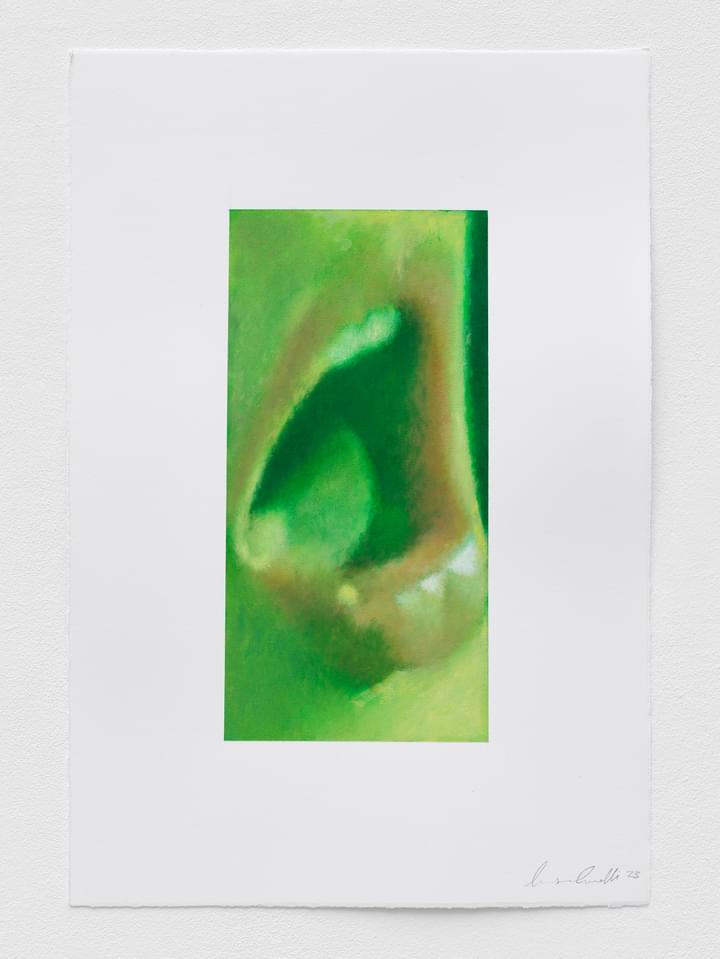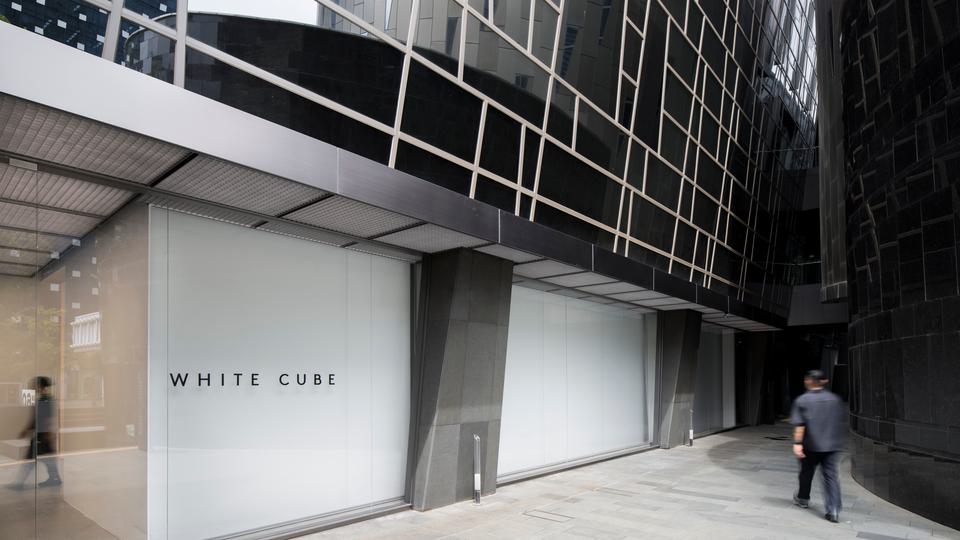
The Embodied Spirit (Seoul 2023)
Dates
5 September – 21 December 2023
‘The Embodied Spirit’ brings together works which explore ideas around philosophy, metaphysics and what motivates human behaviour. The inseparable nature of body and psyche, as posited by the Greek philosopher Aristotle in his essay On the Soul (c.350 BCE), provides the basis for a selection of artworks that delve into the mysteries of human existence, interpreting the continuum between matter and spirit.
Christine Ay Tjoe’s paintings examine spiritual concepts and emotional conditions, achieved by a process in which the artist enters a near transcendental state as a route to achieve a merger of what she describes as ‘the seen and unseen’. Delicate colour fragments explode and skitter across the surface plane of the paintings, governed by the artist’s intuition in her search for the interconnectivity between humanity and nature. In the ‘Cryptobiosis’ (2020) works – a term meaning the state of extreme inactivity that an organism enters in response to adverse environmental conditions – Ay Tjoe looks ‘to virtually halt movement and any definite aim ahead; offering possibilities for a longer life and greater hope ahead’.
The enigma of human life and what comes next are the subject of Marguerite Humeau’s wide-ranging practice. Exploring what she describes as ‘the consciousness of our death as individuals and as a species’, Humeau’s sculptures and works on paper present a series of speculative forms and models that she imagines might emerge in a post-Anthropocene world. The Guardian of Termitomyces (2023) takes the form of a totem, based on the termite mounds built through collective cooperation, which the artist sees as a guide to ‘navigate our futures’.
The paintings of Louise Giovanelli explore heightened emotional states, rituals, religion and its iconography. A single image sourced from a 1970s film featuring the sacramental offering to a young woman during a Catholic mass provides the catalyst for a series of paintings in which the protagonists hover somewhere between pious reverence, ecstatic reverie and erotic abandonment. The acid yellow/green pallor that pervades the images alludes to altered perceptions resulting from transubstantiation – the changing of one substance into another.
Lee Jinju’s paintings consider the psychological process of individual memory and perception. Using traditional Korean painting techniques, applying ink or pigment directly on to fabric, her delicately rendered views of hands or the back of a head, focus on details drawn from her personal narrative and subjective approach. As Lee explains, ‘My ‘Black Paintings’ series reveals a hidden yet unmanifested structure where many events and relationships remain concealed in darkness […] I believe that hands, like a person’s face, can express a multitude of emotions’.
Tracey Emin probes the fundamentals of what makes us human with excoriating honesty. Spiritual consciousness and the prospect of an afterlife are recurrent themes, while ideas around love, desire, loss and grief echo throughout the paintings and works on paper. In I Have to Keep Living (2022), the outline of a contorted female figure lying across a bed-like structure with the palimpsest of earlier iterations of a ghost-like form visible beneath, suggests a tumultuous emotional state. In The Next Journey (2023), the supine figure seen on a sarcophagus-shaped crib, appears as if hovering between this life and the next.
Katharina Fritsch’s uncanny sculptures are full of intuitive intent. Based on objects or forms that are instantly familiar, through the application of solid colour or alteration of scale, they take on a more ambiguous and mysterious presence and in doing so present some of the most profound questions of human existence. In Hand (2020), a single outstretched hand, laid flat on a plinth, appears lifelike in its exquisite detail, yet otherworldly in its matt black finish, loaded with association and import.
Embodiments of human fragility, drawn from religious iconography, feature in the work of Berlinde de Bruyckere. Inspired by mythology, Old Master painting and Christian representation, her anamorphic forms focus on the pathos of life, yet through a contemporary lens. The compassionate care provided by nurses and caregivers during the global pandemic triggered a group of sculptures titled the ‘Arcangelo’ series. In Arcangelo Glass Dome II (2021–23), hybrid human forms enveloped in soft fur, extend the metaphor of protection for the vulnerable body.
Featured Works
Featured Artists:
Christine Ay Tjoe was born in 1973 in Bandung, Indonesia, where she studied and continues to live and work. Her work has been exhibited across Asia, including a major retrospective at the 21st Century Museum of Contemporary Art, Kanazawa, Japan (2018), and international group exhibitions including Asia Society Triennial, New York (2020); Royal Academy of Arts, London (2017); National Taiwan Museum of Fine Arts, Taichung (2012); and Singapore Art Museum (2012).
Berlinde De Bruyckere was born in 1964 in Ghent, Belgium, where she lives and works. Solo exhibitions include Bonnefanten Museum, Maastricht, Netherlands (2021); Fondazione Sandretto Re Rebaudengo, Italy (2019); Leopold Museum, Vienna (2016); National Gallery of Iceland, Reykjavik (2016); and Kunsthaus Bregenz, Austria (2015). Group exhibitions include the 55th Venice Biennale (2013) and the 15th Istanbul Biennale (2017).
Tracey Emin was born in 1963 in London. She currently lives and works between London, the South of France and Margate, UK. Emin has exhibited extensively including major exhibitions at the Munch Museum, Oslo (2021–22); Royal Academy of Arts, London (2020); Musée d’Orsay, Paris (2019); Château La Coste, Aix-en-Provence, France (2017); Leopold Museum, Vienna (2015); Museum of Contemporary Art, North Miami, Florida (2013); Museo de Arte Latinoamericano de Buenos Aires (2012); Turner Contemporary, Margate, UK (2012); and Hayward Gallery, London (2011).
Katharina Fritsch was born in 1956 in Essen, Germany and lives and works in Düsseldorf. Solo exhibitions include The George Economou Collection, Athens (2022); Cantor Arts Center, Stanford University, California (2019); Walker Art Center, Minneapolis, Minnesota (2017); Museum Folkwang, Essen, Germany (2016); Contemporary Art Museum, St. Louis, Missouri (2014); Fourth Plinth, Trafalgar Square, London (2013); and Art Institute of Chicago, Illinois (2012). Group exhibitions include the 59th Venice Biennale (2022); Qatar Museum, Doha (2022); Kunstmuseum Basel, Switzerland (2020, 2016); MoMA, New York (2018); Moderna Museet Malmö, Sweden (2016); Art Institute of Chicago, Illinois (2015); Manifesta 10, Saint Petersburg (2014); and the 54th Venice Biennale (2011).
Louise Giovanelli (b.1993) lives and works in Manchester, UK. She studied at Städelschule, Frankfurt (2018–20) under the tutelage of Amy Sillman, having received her BA from the Manchester School of Art, UK, in 2015. Solo exhibitions of her work have been held at Moon Grove, Manchester, UK (2023); Manchester Art Gallery, UK (2019); Workplace Foundation, Gateshead, UK (2019); Warrington Museum and Art Gallery, UK (2018); and The Grundy Gallery, Blackpool, UK (2016). Giovanelli’s work has been featured in group exhibitions that include FLAG Art Foundation, New York (2023); Hayward Gallery, London (2021); AkzoNobel Art Foundation, Amsterdam (2021); and The Art House, Worcester, UK (2019).
Marguerite Humeau was born in 1986 in Cholet, France. She currently lives and works in London. Solo exhibitions include Lafayette Anticipations, Paris (2021); Jeu de Paume, Paris (2020); Kunstverein in Hamburg, Germany (2019); Museion, Bolzano, Italy (2019); New Museum, New York (2018); Tate Britain, London (2017); Haus Konstruktiv, Zurich (2017); Schinkel Pavillon, Berlin (2017); Nottingham Contemporary, UK (2016); and Palais de Tokyo, Paris (2016). Group exhibitions include the 59th Venice Biennale (2022); Kunsthalle Basel, Switzerland (2021); the Istanbul Biennial (2019); Centre Pompidou, Paris (2019); Musée d’Art Moderne de la Ville de Paris (2019); the High Line, New York (2017); Château de Versailles, France (2017); and Serpentine Galleries, London (2014).
Lee Jinju was born in 1980 in Busan, South Korea. She lives and works in Paju and Seoul. Solo exhibitions include Arario Museum, Jeju, South Korea (2021); Baik Art, Los Angeles, California (2017); Doosan Gallery, New York (2014); and Gallery Hyundai, Seoul (2011). Group exhibitions include SongEun Art Space, Seoul (2022); National Museum of Modern and Contemporary Art, Seoul (2021); American University Museum, Washington (2016); Seoul Museum of Art, South Korea (2015); and the Korean Cultural Centre, London (2011).
Susan May is Global Artistic Director at White Cube. Alongside overseeing the gallery’s international programme, she has curated numerous exhibitions including ‘Memory Palace’, White Cube Bermondsey and Mason’s Yard, London (2018); ‘The Gesture and The Sign’, White Cube São Paulo (2013); and ‘Kupferstichkabinett: Between Thought and Action’, White Cube Hoxton Square, London (2010). Prior to this, she was Head of the UK's Arts Council Collection, the largest national loan collection of modern and contemporary British art in the world, and was formerly a Curator at Tate Modern, London, where she curated major exhibitions and commissions including ‘The Weather Project’ by Olafur Eliasson (2003) and ‘Double Bind’ by Juan Muñoz (2001).
In the Gallery: White Cube Seoul
Visit
White Cube Seoul
Situated in the heart of the bustling Gangnam-gu district and spanning over 300m², White Cube Seoul marks the gallery’s second public space in Asia.
Located in close proximity to Dosan Park and cultural institutions, including the SONGEUN Art and Cultural Foundation, the striking, ceramic-encased building is also home to the Horim Art Centre, a renowned private museum with an extensive collection of Korean modern art and antiquities.
Create an Account
To view available artworks and access prices.











